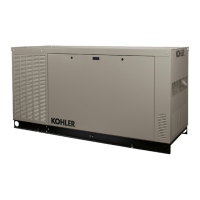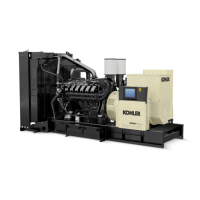COOLING SYSTEMS
RADIATOR SYSTEMS
Coolant is circulated through .the engine arid radiator by a belt driven water pump.
When the
engine is cold, the thermostat (in housing on top of cylinder head) remains closed to cause coolant to
by-pass the radiator thus resulting in rapid warm-up. As the engine warms, the thermostat opens
to allpw water to circulate into and through the radiator core.
Heated water enters at the top of the
radiator, is cooled, then flows out at bottom to recirculate back into and through the engine water
jacket. A pusher type fan pulls cooling air across the generator and engine, forces the air through c
the radiator core and expels it as heated air through the front of the radiator.
RADIATOR CAPACITIES: There are several styles of radiators in use.
All are for pressure systems,
so=nake sure the correct pressure type cap is used.
Radiator type cooling system capacity is about 7
quarts of liquid. When operating in climates subject to freezing temperatures, make sure a sufficient
amount of anti-freeze solution is added to prevent freeze up of the system.
On the type of radiator
shown below, a petcock is provided on the underside of the radiator to drain the system.
On other types
the petcock is on-the inlet elbow to the crankcase.
When draining coolant system, remove the radiator
cap and open the drain valve on crankcase near the oil filler cap to prevent air pockets from forming
and blocking water in passages in the block.
Check coolant level frequently and add water or anti-freeze
as needed to maintain correct level.
ANTI-FREEZE. PROTECTION
Closed system such as the radiator and the heat exchanger type cooling systems can be protected
with anti-freeze.
Direct type marine and many city water cooling systems are llopen circuittl systems
and cannot therefore be protected with anti-freeze.
Before adding anti-freeze, drain the coolait sys-
tem completely to assure correct proportions of anti-freeze to water.
Radiator systems hold about 7
quarts of liquid while the marine type heat exchanger system (page 6.3) holds about 5 quarts.
If, for
example, you want to protect a 7 quart capacity radiator system down to 11’ below zero with ethylene
glycol, use a 40% solution per the chart below--this is figured as .40 x 7
= 2.80 or rounded off, 3
quarts anti-freeze to 4 quarts of water.
For maximum protection always use a solution which will
remain liquid well below the lowest anticipated temperature.
ANTI-FREEZE PROTECTION CHART
ANTI-FREEZE
I
10%.
I
20%
I
30%
I
40%
I
50%
ETHYLENE GLYCOL 1
.**
I
+t 6”
I
+3”
I
-Ito _
I
-31 O
GLYCERINE TYPE 1
+29”
I
+2t O
I
+t 2”
I
O0
I
a0
LOUVERS FOR
CONTROLLER
VENTIUTION -
DRAIN l
VALVE
PUSHER FP
FI GURt 6- I
-- COOLING AIR C1KCUlATlUN
61
0
